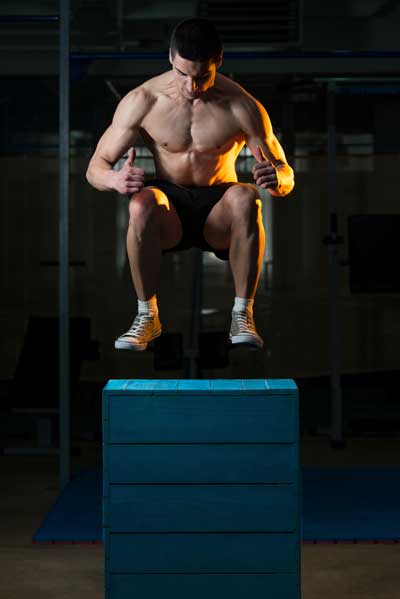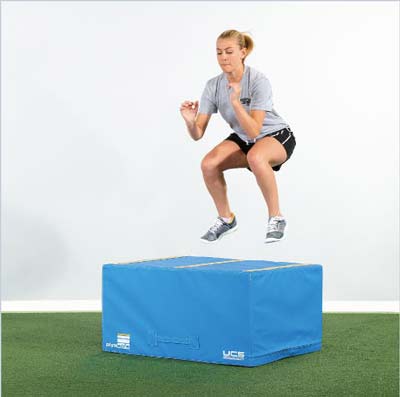
By Carl Valle
Are Box Jumps Good Plyometric Exercises?
For years, I have used box jumps judiciously with athletes and find them a not very valuable option. It is not that it does not have any value, but the obsession people have with box jumps does not seem to make sense if you look at the big picture. Jumping and landing on a box has very little transfer to performance, and with any exercise, I see more and more abuse of the movement. In this article, I objectively look at the exercise as a teaching and training tool and come up with a healthy perspective of how it can be used and when it should be left alone with athletes. My hope is that this article prunes the use of the exercise to what is essential and helps coaches think more generally of any exercise application. Plyometrics and equipment seem to be a favorite combination, but the wrong inclusion can cause injury and stagnation.

Figure 1: Athlete jumps up on the box with knees tucked for increased height.
What is a Box Jump?
To ensure we are on the same page, a very specific definition is needed before we start breaking down box jumps in more detail. When one says we are doing box jumps, it may conjure up different images to different people.
Box Jump – A jumping exercise in which an athlete projects himself or herself from the ground and lands with two feet on an elevated box.
At first glance, a box jump may seem elementary, but be warned. The devil is in the details, and time after time, the details are lost. For example, is the projection from one or two feet, and the initiation from a counter movement or static position? Does the user walk or run to the box, start from a hold, or pre-jump into the projection? How high should the boxes be, and how should we coach the movement? Why are we doing the action in the first place? The above questions exist because many coaches and athletes apply the exercise but do not share a clear rationale for its use and delivery.
The primary reason we do jumping exercises is to exploit the stretch-shortening cycle of the legs to improve the use of elastic energy. The rationale for using box jumps in directly improving this quality is questionable because the very nature of plyometric exercise is creating an overload that box jumps do not accomplish very effectively. Remember that box jumps are just vertical jumps with a landing on a box, something that reduces the impact of the body’s displacement. Vertical jumps with just body weight are low-level exercises in terms of strain on the body, so the return, like the forces they are redirecting, are low in return with power development. When we do vertical jumps for testing purposes, it is to see how the training is improving the expression of power. You can get more improvement in power by doing vertical jumps, but it is very small and only with beginners. Athletes tend to either overload the body with external weighted exercises or use their bodies with a higher strain of gravity. To make it simple, coaches and athletes are trying to make the landing more demanding than landing on a pillow. The overload of one’s body has to be far greater than normal to force adaptation. Landing on a box means you are not dropping down farther but dropping down less. Why are we decreasing the strain of landing and expecting athletic enhancement?
Common Reasons Coaches Use Box Jumps
Why do coaches and athletes do box jumps, and why are they so popular? Box jumps are popular because they look impressive and appear to have a value beyond just using the ground. Clearly, a box is a useful way for some athletes to increase the demand of when they jump off them, but why the overzealousness for jumping on them? I believe the three reasons listed are why athletes are doing box jumps.
- Motivating — Jumping up and down in place is extremely valuable at all levels, and countless options exist. I find that jumps in place, like tuck jumps and split jumps, are good early activities, but for some reason, no beginners exist, and everyone tends to skip to more demanding exercises. Jumping on a box forces the athlete to put a degree of effort to accomplish the task, and the box height is more of a motivational tool. Shared earlier, arousal levels stemming from the sympathetic nervous system is important to think about when one creates training programs with athletes. Unfortunately, jumping on a 55-inch box does not mean displacing the center of mass 55 inches, so anyone listing box jump heights is usually showcasing the ability to create triple flexion in the air rather than triple extension through the ground. A tall box raises the effort with athletes, but the key is to raise the ability of the athlete after the training.
- Teaching — Some coaches teach movements with the box because the landing is purposely less than normal, and the effort is nearly maximal. Teaching an athlete to move with maximum effort with near-maximal technique and safety is a popular reason in doing box jumps. The low strain of landing on the box enables more repetitions and exposure to coaching. With enough reps and time, coaches can help shape the synchronization of the legs and arms better in box jumps. While box jumps are remedial, the benefit is that athletes learn by doing. Box jumps are very useful tools when applied. Although athletes can work between rest periods, the boxes are not cheap and requires sharing; so, they are not 1:1 style training options. I prefer no more than a 4 to 1 ratio of boxes to athletes, since they are not that tiring.
- Copying — Arguably, many coaches do box jumps because they see high profile athletes doing them or believe that using the boxes must mean they are great for exercise. The “monkey see, monkey do” problem we have with coaching is nothing new, but one of the reasons this article exists is to prevent the blind use of them and ensure they are done properly and purposely. Copying is okay, since good sources and good training should influence others, but many times, when someone starts copying, he or she stops thinking.
The Hidden Risks of Box Jumps
The box jumps with low-height and wide-base boxes one sees in good equipment catalogs are usually excellent options because the materials and construction is of quality. The problem with good boxes is that they are large and durable, and that means expensive. Cheap, metal cage-like options are used, and the best boxes are square and soft, unless they are very short platform boxes for track athletes. Some boxes are stackable or able to nest for convenience, and those resemble pyramid-like structures. The problem with pyramid-style boxes is that they have a narrow landing top, and this reinforces unnatural and unsafe landings. A good landing is hip-wide or wider, and some boxes force a landing that is extremely narrow and resembles a soldier standing at attention. To summarize, box construction is a major part of where risk can originate, and the wrong box will increase the risk of falling off and how damaging the fall is.

Figure 2: Many coaches like wide padded boxes from Perform Better since they are safe and very practical for different ability levels. Don’t invest in cheaper pyramid style boxes; they are not good for landing on and are known to scrape athlete’s skin if something goes wrong.
Falling off a box can happen and will happen. All it takes is one athlete having a brain hiccup and placing their feet incorrectly as they displace themselves in the air. This can come from fatigue, lack of focus, or common human error. The higher the box means higher the risk, since falling from a greater height means more stuff can happen. An athlete can skin their shins, fall off and sprain a wrist or finger, or break a bone. Even before landing, athletes can get hurt since a hand can be too close to the box and be damaged. I have seen a jump initiated too close to a hard box and the finger, and the aftereffects were rather gruesome—envision a ketchup packet being stepped on.
Tips on Better Box Jumps
Over the years, I have heard some good ideas for executing the box jumps better, but none exhausted all of the different options. I have created a list of how to use box jumps effectively. These are simple suggestions; other coaches learned the hard way.
- A prerequisite of box jumping is doing it without any implement or equipment. Even before doing double-leg jumping, an athlete should perform squat and lunge patterns with various positions, speeds, depths, and arm actions. After speed patterns without projection are solid, it is good to progress to jumping in place before adding the boxes.
- Distance from the box should be wide enough, so there is no risk in hitting the box during the arm swing. One thing I wish I am better at is marking the floor with gaffing tape so that athletes have a consistent jumping pattern. Soccer and football fields are useful since they are pre-marked and provide soft surfaces.
- Redirection or change of direction is lowering the center of mass to project to another direction, usually the opposite. Athletes should land in the same way their leg angles were at the start. Nobody jumps by lowering one’s pelvis so much it touches the ground, so why are we landing on a box that way?
- The heights of the boxes are not as important as the effort to jump high on the box. A threshold exists when an athlete is focused on self-preservation (getting feet up) rather than a quality landing. Any box higher than a meter does not have much value since most jumps with athletes are less than 40 inches. It is better to focus budgets on smaller boxes so more can use them, and advanced athletes can use a weight vest to challenge themselves.
- Equating box height to jumping prowess is like sharing a medicine ball’s weight to validate one’s strength abilities. Just because one is using a specific height does not mean that he or she is achieving anything. Countermovement jumps with and without arms have more validity and remove interpretation and guesswork. It is smarter to use a two-foot box and land from a higher distance rather than force a higher box. Teach with box jumps, and test with countermovement jumps.
- Walking approaches make things more complicated, and the best models for good timing and mechanics are springboard divers. Watching them live you can see a great working example of transitioning from a walking pattern to an athletic-looking jump (and athletic). Running jumps are not a good idea, as they are disasters waiting to happen. Pre-jumping onto a box is very questionable, since repeat hurdle work is a wiser option.
Closing Thoughts on Box Jumps
Box jumps are a tiny fraction of plyometric options, and one can argue they are just a way to get on the box for depth and drop jumping. They are mainly used for teaching and training beginners and sometimes are good for athletes who are stale or want a good warm-up. Box jumps can be thought of as speed bodyweight squats with a soft landing so advanced athletes will not benefit that much from adding them to a program. Finally, you get what you pay for with boxes. It’s better to buy less and get nice wide, padded boxes than to bargain shop for pyramid frame style boxes that are an accident waiting to happen.
Please share this article so others may benefit.
[mashshare]



You are an idiot. Whatever degrees you have
Have obviously fogged your ability to admire and objectively give your opinion on this wonderful exercise.
First, box jumping takes a significant amount of strength and endurance. Used as a warmup? Seriously?
Try to do 10 reps at 36″ let me know how that works out for you
What a idiot do this after a killer track workout or 100m weight training program at 32-36″ then talk I’m done
Box Jumps: I’m convinced of you ever perform box jumps for max height or for AMRAP workouts… You’re either an idiot and missing the point entirely.
Please tell me what are the benefits of box jump , I want to build my leg calves , thigh muscle and butt?
Well facts are facts box jumps are great and your a idiot
Always good to be skeptical and analyse exercises. Too many fast assumptions out there.
Problem I see with this article is that it tries to criticize box jumps, however when you read it, there are only some OK guidelines and no really critic.
This is how I see it.
Interesting article Carl (and even more interesting comments!)
Whilst I can see both sides, there’s no doubt that box jumps do provide a lot of benefits.
Kate
I thought you made some very good points Carl. As a physical therapist, I work with many athletes who have injured themselves in the gym, not on the playing field. The box jump looks impressive, but that’s it.